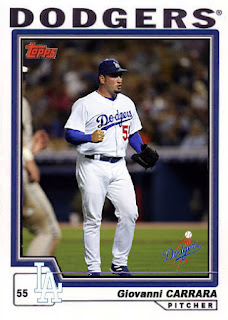After winning the KOD13 Championship with the 1981 Dodgers as a late season hire, Keith MacDonald earned the right to have his "interim" status changed to "full time manager". Keith had an incredible run with LA, which barely earned the final wild card spot as entry into the post season. Blame the squarely on previous management, as Keith righted the ship and restored the proper chemistry that it takes to win a pennant and then hang a banner up. Keith's first full time shot at managing one of the NL's most prestigious franchises will be with the Cinderella 2004 edition, which went 93-69 to win the NL West by 2 games over their bitter rivals in San Fran.
On paper this team looks to have played way over their heads, which is evidenced by the 50+ come from behind wins that they posted. Offensively this team has about as much power as you can hope for considering that they played 81 games in the pitcher friendly Dodger Stadium. MVP runner-up Adrian Beltre led the league with 48 round trippers and .334 average with over 120 RBI's in what turned out to be a career year. Beltre parlayed his good fortune into a lucrative free agent deal the following season with the Mariners. Of the 8 regulars only shortstop Cesar Izturis failed to reach double digits in homers. He did however hit .288 while stealing 25 bases. Next to Beltre Shawn Green had the second most homers on the team (28). The key to the team was the trading deadline acquisition of center fielder Steve Finley, who at the age of 39 hit .263 with 13 homers in just 250 AB's. Interestingly by joining the Dodgers Finley rounded out his resume to include playing time with every NL West team.
The pitching was descent finishing 4th in the league in ERA with a bloated 4.01 steroid era ERA. The staff did not really possess an ace. They did however have a leader in Jose Lima (13-5, 4.07). "Lima Time" as it came to be know in Southern California was an event for all to see. When the animated Lima took the mound wild and wacky things happened, including some improbably Dodger wins. When a player hit a big moment homer Lima was the first guy out of the dugout to celebrate. He was clutch too. He notched LA's only win in the NLCS vs St. Louis. Kaz Ishii, Jeff Weaver and Odalis Perez were solid contributors. 5th starter Hideo Nomo in his second tour of duty in Chavez Ravine was horrible. In 18 starts he was 4-11 with an 8.25 ERA. When healthy, Wilson Alvarez (7-6, 4.03) is LA's best option for the #5 slot.
The starters need to go 6 or 7 innings then hand the ball off to the best pen in the NL. Duaner Sanchez, Yhency Brazoban, Giovanni Carrara, and Guillermo Mota all have one goal: Hold the lead and get the ball in the hands of closer Eric Gagne (7-3, 2.19, 45 saves). Gagne was in the final year of a glorious stretch where he won the Fireman of the Year Award as well as the 2003 NL Cy Young Award. Most heralded him as the best reliever in baseball. Years later we would come to know that Gagne was a fraud. He was outed in the Mitchell Report as a known PED user. Gagne's career fell off the table after 2004. Injuries and lack of juice turned this once dominating fireballer into an 87mph batting practice pitcher. Still he is the most important cog in the 2004 Dodgers arsenal and as close to a sure thing as any manager can find in the 9th inning.
Since the Dodgers uses a lot of pitchers in 2004 (Twenty One to be exact), there were a lot of cards needed to update the team set. 21 total cards were added (12 pitchers). I didn't have to colorize any cards and it was pretty easy tracking down usable photos thanks to the fact that the Dodgers kept a 2004 pictorial journal on their website. The 2004 Topps template was a bit challenging to create because Topps used a stick figure outline of each players photo on the bottom left hand side right next to the player's uniform number. It would have taken countless hours to create these outlines for each individual player, so I elected to replace that feature across the board with a stick figure outline of the "LA" logo.
Since the Dodgers uses a lot of pitchers in 2004 (Twenty One to be exact), there were a lot of cards needed to update the team set. 21 total cards were added (12 pitchers). I didn't have to colorize any cards and it was pretty easy tracking down usable photos thanks to the fact that the Dodgers kept a 2004 pictorial journal on their website. The 2004 Topps template was a bit challenging to create because Topps used a stick figure outline of each players photo on the bottom left hand side right next to the player's uniform number. It would have taken countless hours to create these outlines for each individual player, so I elected to replace that feature across the board with a stick figure outline of the "LA" logo.




















































